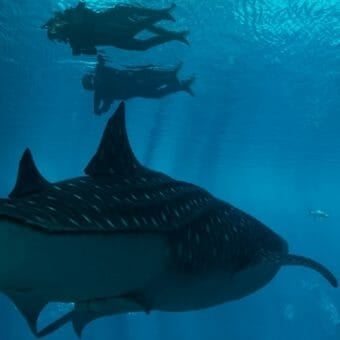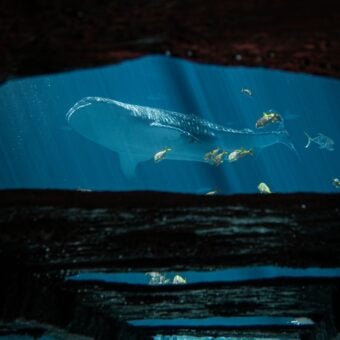-
Size
18 feet (5.5 m) -
Diet
Slow schooling fishes -
Range
Indo-West Pacific -
Habitat
Found in shallow bays, lagoons and estuaries
Physical Characteristics
- Common length of 18 feet (5.5 m), with a maximum length of 24 feet (7 m).
- Heavy, shark like body; very flat on ventral side.
- Long, narrow rostrum is common to all sawfish. In this species, the “saw” is the longest of all, reaching a maximum length of 5 feet (1.5 m).
- Typically has 25-34 rostral teeth (actually modified dermal denticles) on either side of the saw.
- Displays countershading; dark olive or grey on the dorsal side and pale yellow or white underneath.
Animal Fact
Sawfishes are particularly susceptible to being captured as bycatch, because their long, toothed rostrums are easily ensnared in fishing nets. Sawfishes are listed as “Critically Endangered” on the International Union for the Conservation of Nature’s Red List.
Diet / Feeding
- Diet consists primarily of slow schooling fishes, such as mullet.
- The longcomb sawfish will use its rostrum to help it hunt or forage for food. It will first swim alongside its prey and then strike it with a sudden swipe of its toothed rostrum. This sawfish may also use its rostrum to stir up the sandy bottom to find bottom-dwelling crustaceans and shellfish.
Range / Habitat
- Occurs in the Indo-West Pacific, Australia and Papua New Guinea, eastern coast of Africa and the Red Sea, as well as China and New South Wales.
- Mainly bottom-dwelling and found in shallow bays, lagoons and estuaries. Has been found at depths up to 130 feet (40 m), but 1-16 feet (0.3-5 m) seems to be most common.
Reproduction & Growth
- Ovoviviparous- eggs are hatched internally.
- Reaches maturity after 9 years.
- Females can have litters of approximately 12 pups.
Conservation Status
- “Critically Endangered” on the IUCN Red List.
Additional Information
- Also known as the “green” sawfish and the “narrow snout” sawfish.
- Vulnerable to nets; both fishing and shark control nets surrounding beaches.
- Predators include tiger and bull sharks, as well as freshwater crocodiles.
- It has been suggested (Grant, 1978) that adult males will use their saws in dominance and mating battles.





